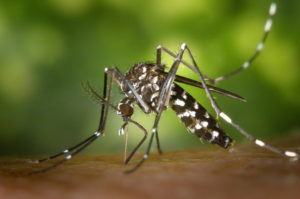
The first Zika-related death has occurred in the continental United States. A resident of Salt Lake County in Utah died by contracting the virus after traveling to parts of the world where the Zika virus is active. The Salt Lake County resident was also elderly and had an underlying condition according to the press release from the Salt Lake County Health Department.
The announcement came July 8th. The health department also stated that while the person did test positive for the virus, due to health privacy laws (HIPAA), health officials cannot and will not release further details about the person, as well as their travel history other than the person died in late June, tested positive for Zika, was elderly and traveled to a Zika affected region.
Dangers
Mosquito experts assure residents of Salt Lake County that there is no threat of Zika virus infection from the mosquitos in the area. Dr. Ari Faraji, manager of the Salt Lake City Mosquito Abatement District stated, “The exotic mosquito species capable of transmitting Zika virus are not found along the Wasatch Front. In fact, so far this season, we have not deemed those two species (Aedes aegypti and Aedes albopictus) anywhere in Utah.”
Current Locations
Health officials haven’t identified any Zika infections transmitted by local mosquitoes in regions of the continental United States where mosquitoes capable of carrying Zika virus are found. The most updated information about where mosquitoes are spreading Zika can be found on the Centers for Disease Control and Prevention’s website.
Transmission
Health officials also caution that sexual activity can transmit Zika. Women that are trying to become pregnant or are pregnant should not have unprotected sex with a man that has recently traveled to a Zika affected region.
Travel Warnings
Dr. Dagmar Vitek, medical director of Salt Lake County Health Department said, “This unfortunate situation is a tragic reminder of how important it is to receive proper pre-travel education and to protect yourself from mosquitoes when traveling abroad. Travelers need to also be mindful of other diseases found around the world, including mosquito-borne illnesses like Dengue fever, malaria, and chikungunya.”
You can visit the CDC website on travel information for the latest information on the Zika virus areas, as well as information on other diseases that are showing prominence worldwide. It is also recommended that you contact your physician for recommended vaccines if you are planning on traveling to any third world or underdeveloped country, or if you are unsure if the country you are going to may require a vaccination. Please note, there is no vaccination for the Zika virus at this time, so take extra precautions if you are planning to visit an area currently affected with the Zika virus.

 ince the World Health Organization declared the Zika virus outbreak a public health emergency, there has been a lot of international concern. This summer, Rio de Janeiro in Brazil is hosting the Summer Olympics, but unfortunately, Rio lies in a Zika virus-affected area. Some Rio officials
ince the World Health Organization declared the Zika virus outbreak a public health emergency, there has been a lot of international concern. This summer, Rio de Janeiro in Brazil is hosting the Summer Olympics, but unfortunately, Rio lies in a Zika virus-affected area. Some Rio officials 
